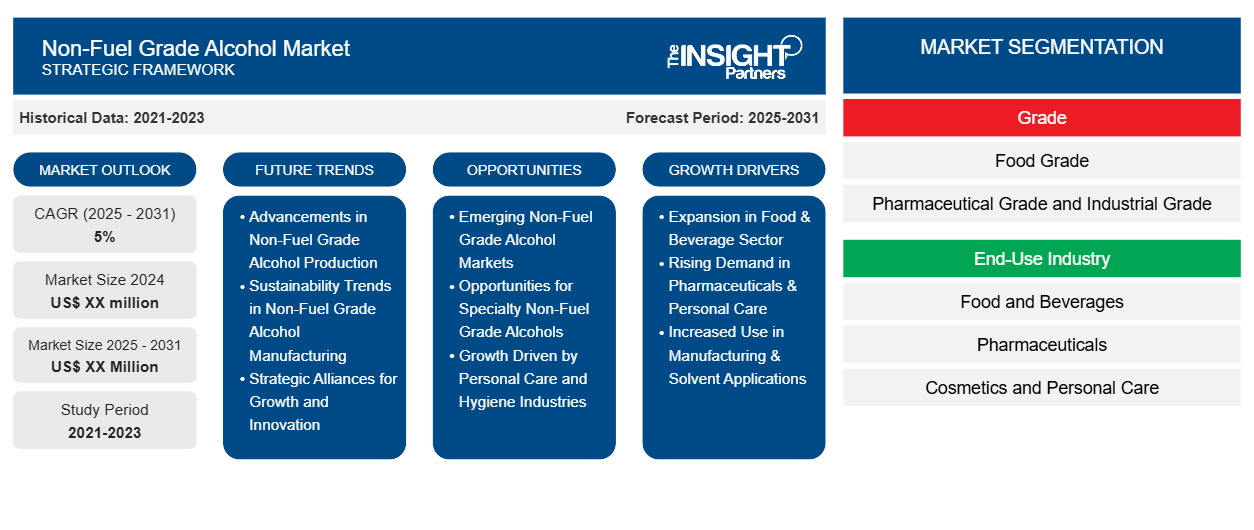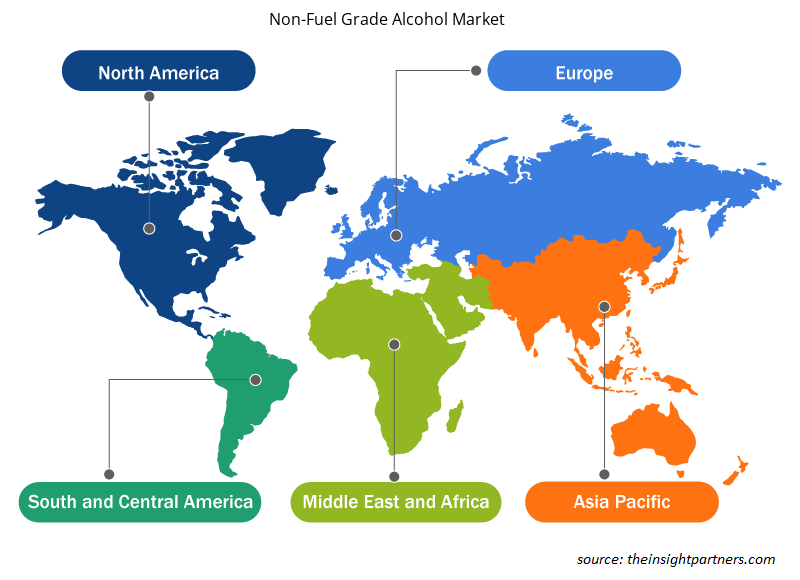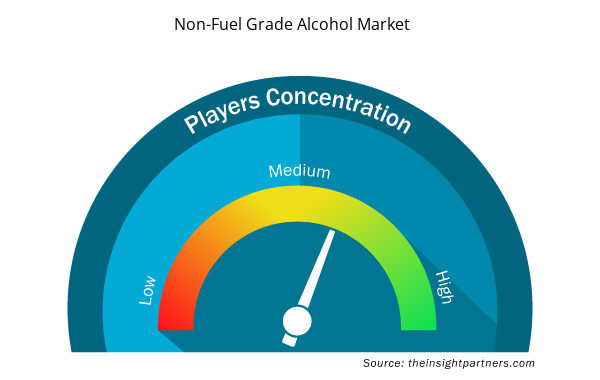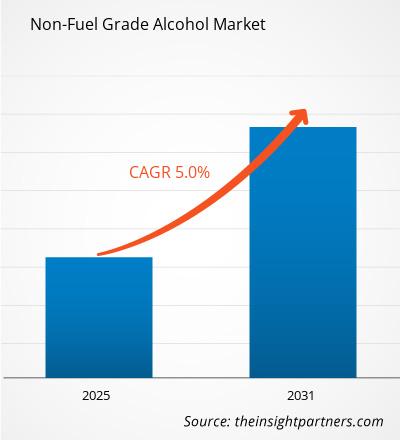Se espera que el mercado de alcohol de grado no combustible registre una CAGR del 5 % entre 2025 y 2031, con un tamaño de mercado que se expandirá de US$ XX millones en 2024 a US$ XX millones en 2031.
El informe está segmentado por grado (alimentario, farmacéutico e industrial). Además, presenta un análisis basado en la industria de uso final (alimentos y bebidas, productos farmacéuticos, cosméticos y cuidado personal, productos químicos, entre otros). El análisis global se desglosa a nivel regional y por países principales. El alcance del informe abarca el tamaño y las previsiones del mercado a nivel global, regional y nacional para todos los segmentos clave. El informe ofrece el valor en USD de los análisis y segmentos mencionados. El informe proporciona estadísticas clave sobre el estado del mercado de los principales actores y presenta tendencias y oportunidades.
Propósito del Informe
El informe "Mercado de Alcohol de Grado No Combustible" de The Insight Partners busca describir el panorama actual y el crecimiento futuro, los principales factores impulsores, los desafíos y las oportunidades. Esto proporcionará información a diversos actores del sector, como:
- Proveedores/Fabricantes de Tecnología: Para comprender la dinámica cambiante del mercado y conocer las oportunidades potenciales de crecimiento, lo que les permitirá tomar decisiones estratégicas informadas.
- Inversores: Realizar un análisis exhaustivo de tendencias respecto a la tasa de crecimiento del mercado, las proyecciones financieras del mercado y las oportunidades que existen en toda la cadena de valor.
- Organismos reguladores: Regular las políticas y las actividades policiales en el mercado con el objetivo de minimizar el abuso, preservar la confianza de los inversores y defender la integridad y estabilidad del mercado.
Segmentación del mercado de alcoholes no combustibles
Calificación
- Grado alimenticio
- Grado farmacéutico y grado industrial
Industria de uso final
- Alimentos y bebidas
- productos farmacéuticos
- Cosméticos y cuidado personal
- Productos químicos y otros
Personalice este informe según sus necesidades
Obtendrá personalización en cualquier informe, sin cargo, incluidas partes de este informe o análisis a nivel de país, paquete de datos de Excel, así como también grandes ofertas y descuentos para empresas emergentes y universidades.
Mercado de alcoholes no combustibles: Perspectivas estratégicas

- Obtenga las principales tendencias clave del mercado de este informe.Esta muestra GRATUITA incluirá análisis de datos, desde tendencias del mercado hasta estimaciones y pronósticos.
Factores que impulsan el crecimiento del mercado de alcoholes no combustibles
- Expansión en el sector de alimentos y bebidas: El creciente consumo de alcohol en este sector sigue siendo uno de los factores clave que impulsan el crecimiento del mercado de alcoholes no combustibles. El etanol es un alcohol esencial, ampliamente utilizado en el procesamiento de alimentos como conservante, aromatizante y disolvente. La experiencia en bebidas artesanales y la disponibilidad de bebidas premium listas para beber (RTD), a menudo mezcladas con alcohol y licores con sabores espirituosos, aumentan la demanda de alcoholes no combustibles de alta calidad.RTD)-often blended in alcohol and spirituous flavored liquors-increasing demand for non-fuel grade alcohol of high standards.
- Aumento de la demanda en productos farmacéuticos y de cuidado personal: Otra categoría de alcoholes no combustibles donde el etanol y el alcohol isopropílico tienen mayor aplicación es en productos farmacéuticos y de cuidado personal. Estos alcoholes se encuentran en frotaciones, solventes y también en la desinfección. El mercado mundial de productos básicos se ha visto alterado por la adopción de medidas sanitarias para garantizar la seguridad debido a pandemias como la COVID-19, ya que las personas mantienen estándares saludables de higiene, lo que aumenta el consumo de desinfectantes. Es probable que esta tendencia persista, lo que explica la consideración de alcoholes no combustibles en el uso industrial, lo que generará una mayor demanda.
- Mayor uso en la fabricación y aplicaciones de disolventes: Los disolventes de alcohol no combustible son cruciales en todas las instalaciones, incluyendo recubrimientos, adhesivos e incluso agentes de limpieza. Con el crecimiento del sector manufacturero en países en desarrollo, el consumo de disolventes está en aumento, lo que también impulsa el mercado de alcohol no combustible. A medida que los métodos de producción se transforman con nuevas técnicas y máquinas para maximizar la producción, también lo hará el uso de alcoholes no combustibles en los procesos de fabricación.
Tendencias futuras del mercado de alcoholes no combustibles
- Avances en la producción de alcohol no combustible: La eficiencia y la sostenibilidad de la producción de bebidas alcohólicas no combustibles han mejorado significativamente gracias a las tecnologías recientes. Se ha adoptado la optimización de la fermentación y el uso de otros procesos bioquímicos para la producción de etanol y otros tipos de alcohol. Estas tecnologías buscan reducir los costos de producción y los efectos adversos de la contaminación en las prácticas, una tendencia en la sociedad moderna en cuanto a sostenibilidad en las industrias químicas.
- Tendencias de sostenibilidad en la fabricación de alcoholes no combustibles: La preocupación por la sostenibilidad en la producción y venta de alcoholes no combustibles es evidente en el mercado actual. Cada vez más empresas optan por métodos de producción de alcohol que incluyen el uso de materias primas de cultivos y el reciclaje de otros alcoholes. La razón por la que el mercado está cambiando hacia este suministro de alcohol más sostenible se debe a la demanda de soluciones ecológicas por parte de los consumidores y a las regulaciones que limitan las emisiones de gases de efecto invernadero. Estos cambios en los mercados, junto con las prácticas sostenibles en la adopción de procesos de fabricación ecológicos, impulsarán a algunos fabricantes a la vanguardia de dicho mercado.
- Alianzas estratégicas para el crecimiento y la innovación: Los actores del mercado de alcoholes no combustibles están formando alianzas estratégicas para mejorar sus productos y servicios y aumentar su presencia. Las alianzas estratégicas entre fabricantes de alcohol, empresas tecnológicas y centros de investigación promueven el desarrollo y crean nuevos mercados para estos alcoholes. Estas estrategias contribuyen a mantener su relevancia en un entorno empresarial caracterizado por la rápida evolución tecnológica.
Oportunidades de mercado para alcoholes no combustibles
- Mercados emergentes de alcoholes no combustibles: Surgen nuevos mercados de alcoholes no combustibles en países como Asia-Pacífico y Latinoamérica, con un gran potencial de crecimiento. Estas regiones se resisten a un crecimiento económico y una industrialización excesivos, pero si se concretan, se espera que los alcoholes no combustibles se expandan a todas las demás áreas que los requieren, lo que incrementará su demanda. Las empresas capaces de identificar la demanda en estos mercados y localizar su producto experimentarán una expansión.baulk from too much economic growth and industrialization yet if carried out the non-fuel grade alcohols is expected to permeate into all other areas that call for their use and thus the demand for them will escalate. Expansion will be seen by those companies able to find the demand in these markets and localize their product.
- Oportunidades para alcoholes especiales de grado no combustible: Existe un gran potencial para los fabricantes gracias a los alcoholes especiales de grado no combustible que se adaptan a aplicaciones específicas. Por ejemplo, se puede acceder al mercado buscando alcoholes de alta pureza para la industria farmacéutica o estructuras de alcohol únicas para ciertas aplicaciones industriales. Modificar los productos según las diferentes demandas industriales permitirá ampliar el mercado y aumentar las ganancias.
- Crecimiento impulsado por las industrias del cuidado personal y la higiene: El crecimiento de las industrias del cuidado personal y la higiene crea una perspectiva atractiva para el mercado de alcoholes no combustibles. La demanda de productos como desinfectantes de manos y desinfectantes genera oportunidades para que los fabricantes recurran a estos alcoholes con nuevas estrategias. Esto impulsará la demanda de crecimiento de los productos fabricados en este segmento, ya que las expectativas de los clientes en cuanto a eficacia y seguridad no se verán comprometidas.
Perspectivas regionales del mercado de alcoholes no combustibles
Los analistas de Insight Partners han explicado detalladamente las tendencias y los factores regionales que influyen en el mercado de alcohol no combustible durante el período de pronóstico. Esta sección también analiza los segmentos y la geografía del mercado de alcohol no combustible en América del Norte, Europa, Asia Pacífico, Oriente Medio y África, y América del Sur y Central.

- Obtenga los datos regionales específicos para el mercado de alcohol no combustible
Alcance del informe de mercado de alcoholes no combustibles
| Atributo del informe | Detalles |
|---|---|
| Tamaño del mercado en 2024 | US$ XX millones |
| Tamaño del mercado en 2031 | US$ XX millones |
| CAGR global (2025-2031) | 5% |
| Datos históricos | 2021-2023 |
| Período de pronóstico | 2025-2031 |
| Segmentos cubiertos | Por grado
|
| Regiones y países cubiertos | América del norte
|
| Líderes del mercado y perfiles de empresas clave |
|
Densidad de actores del mercado de alcoholes no combustibles: comprensión de su impacto en la dinámica empresarial
El mercado de alcohol no combustible está creciendo rápidamente, impulsado por la creciente demanda del usuario final debido a factores como la evolución de las preferencias de los consumidores, los avances tecnológicos y un mayor conocimiento de los beneficios del producto. A medida que aumenta la demanda, las empresas amplían su oferta, innovan para satisfacer las necesidades de los consumidores y aprovechan las tendencias emergentes, lo que impulsa aún más el crecimiento del mercado.
La densidad de actores del mercado se refiere a la distribución de empresas o compañías que operan en un mercado o sector en particular. Indica cuántos competidores (actores del mercado) hay en un mercado determinado en relación con su tamaño o valor total.
Las principales empresas que operan en el mercado de alcohol no combustible son:
- Archer Daniels Midl y compañía
- Cargill, Incorporated
- CropEnergies AG
- Godavari Biorefineries Ltd
- LyondellBasell Industries Holdings BV
Descargo de responsabilidad : Las empresas enumeradas anteriormente no están clasificadas en ningún orden particular.

- Obtenga una descripción general de los principales actores clave del mercado de alcohol no combustible
Puntos clave de venta
- Cobertura integral: el informe cubre de manera integral el análisis de productos, servicios, tipos y usuarios finales del mercado de alcohol de grado no combustible, proporcionando un panorama holístico.
- Análisis de expertos: el informe se compila con base en el conocimiento profundo de expertos y analistas de la industria.
- Información actualizada: El informe asegura relevancia comercial debido a su cobertura de información reciente y tendencias de datos.
- Opciones de personalización: este informe se puede personalizar para satisfacer los requisitos específicos del cliente y adaptarse adecuadamente a las estrategias comerciales.
Por lo tanto, el informe de investigación sobre el mercado de alcoholes no combustibles puede ayudar a descifrar y comprender el panorama de la industria y sus perspectivas de crecimiento. Si bien existen algunas preocupaciones válidas, las ventajas generales de este informe suelen superar las desventajas.
- Análisis histórico (2 años), año base, pronóstico (7 años) con CAGR
- Análisis PEST y FODA
- Tamaño del mercado Valor/volumen: global, regional, nacional
- Industria y panorama competitivo
- Conjunto de datos de Excel



Report Coverage
Revenue forecast, Company Analysis, Industry landscape, Growth factors, and Trends

Segment Covered
This text is related
to segments covered.

Regional Scope
North America, Europe, Asia Pacific, Middle East & Africa, South & Central America

Country Scope
This text is related
to country scope.
Preguntas frecuentes
Innovation in production processes is expected to be the key market trends
The report can be delivered in PDF/Word format, we can also share excel data sheet based on request.
On the basis of geography, the non-fuel grade alcohol market is classified into North America, Europe, Asia Pacific, Middle East and Africa, and South and Central America
Archer Daniels Midland Company; Cargill Inc; Lallemand Inc; Green Plains Inc; Godavari Biorefineries Ltd are some of the key players operating in the non-fuel grade alcohol market
Increasing demand in the food and beverage sector is driving the market growth
The Non-Fuel Grade Alcohol Market is estimated to witness a CAGR of 5% from 2023 to 2031
Trends and growth analysis reports related to Chemicals and Materials : READ MORE..
1. Archer Daniels Midl and Company2. Cargill, Incorporated3. CropEnergies AG4. Godavari Biorefineries Ltd5. LyondellBasell Industries Holdings BV6. Merck KGaA7. Pannonia Bio8. Sasol9. Solvay10. Wilmar Bioethanol
The Insight Partners performs research in 4 major stages: Data Collection & Secondary Research, Primary Research, Data Analysis and Data Triangulation & Final Review.
- Data Collection and Secondary Research:
As a market research and consulting firm operating from a decade, we have published and advised several client across the globe. First step for any study will start with an assessment of currently available data and insights from existing reports. Further, historical and current market information is collected from Investor Presentations, Annual Reports, SEC Filings, etc., and other information related to company’s performance and market positioning are gathered from Paid Databases (Factiva, Hoovers, and Reuters) and various other publications available in public domain.
Several associations trade associates, technical forums, institutes, societies and organization are accessed to gain technical as well as market related insights through their publications such as research papers, blogs and press releases related to the studies are referred to get cues about the market. Further, white papers, journals, magazines, and other news articles published in last 3 years are scrutinized and analyzed to understand the current market trends.
- Primary Research:
The primarily interview analysis comprise of data obtained from industry participants interview and answers to survey questions gathered by in-house primary team.
For primary research, interviews are conducted with industry experts/CEOs/Marketing Managers/VPs/Subject Matter Experts from both demand and supply side to get a 360-degree view of the market. The primary team conducts several interviews based on the complexity of the markets to understand the various market trends and dynamics which makes research more credible and precise.
A typical research interview fulfils the following functions:
- Provides first-hand information on the market size, market trends, growth trends, competitive landscape, and outlook
- Validates and strengthens in-house secondary research findings
- Develops the analysis team’s expertise and market understanding
Primary research involves email interactions and telephone interviews for each market, category, segment, and sub-segment across geographies. The participants who typically take part in such a process include, but are not limited to:
- Industry participants: VPs, business development managers, market intelligence managers and national sales managers
- Outside experts: Valuation experts, research analysts and key opinion leaders specializing in the electronics and semiconductor industry.
Below is the breakup of our primary respondents by company, designation, and region:

Once we receive the confirmation from primary research sources or primary respondents, we finalize the base year market estimation and forecast the data as per the macroeconomic and microeconomic factors assessed during data collection.
- Data Analysis:
Once data is validated through both secondary as well as primary respondents, we finalize the market estimations by hypothesis formulation and factor analysis at regional and country level.
- Macro-Economic Factor Analysis:
We analyse macroeconomic indicators such the gross domestic product (GDP), increase in the demand for goods and services across industries, technological advancement, regional economic growth, governmental policies, the influence of COVID-19, PEST analysis, and other aspects. This analysis aids in setting benchmarks for various nations/regions and approximating market splits. Additionally, the general trend of the aforementioned components aid in determining the market's development possibilities.
- Country Level Data:
Various factors that are especially aligned to the country are taken into account to determine the market size for a certain area and country, including the presence of vendors, such as headquarters and offices, the country's GDP, demand patterns, and industry growth. To comprehend the market dynamics for the nation, a number of growth variables, inhibitors, application areas, and current market trends are researched. The aforementioned elements aid in determining the country's overall market's growth potential.
- Company Profile:
The “Table of Contents” is formulated by listing and analyzing more than 25 - 30 companies operating in the market ecosystem across geographies. However, we profile only 10 companies as a standard practice in our syndicate reports. These 10 companies comprise leading, emerging, and regional players. Nonetheless, our analysis is not restricted to the 10 listed companies, we also analyze other companies present in the market to develop a holistic view and understand the prevailing trends. The “Company Profiles” section in the report covers key facts, business description, products & services, financial information, SWOT analysis, and key developments. The financial information presented is extracted from the annual reports and official documents of the publicly listed companies. Upon collecting the information for the sections of respective companies, we verify them via various primary sources and then compile the data in respective company profiles. The company level information helps us in deriving the base number as well as in forecasting the market size.
- Developing Base Number:
Aggregation of sales statistics (2020-2022) and macro-economic factor, and other secondary and primary research insights are utilized to arrive at base number and related market shares for 2022. The data gaps are identified in this step and relevant market data is analyzed, collected from paid primary interviews or databases. On finalizing the base year market size, forecasts are developed on the basis of macro-economic, industry and market growth factors and company level analysis.
- Data Triangulation and Final Review:
The market findings and base year market size calculations are validated from supply as well as demand side. Demand side validations are based on macro-economic factor analysis and benchmarks for respective regions and countries. In case of supply side validations, revenues of major companies are estimated (in case not available) based on industry benchmark, approximate number of employees, product portfolio, and primary interviews revenues are gathered. Further revenue from target product/service segment is assessed to avoid overshooting of market statistics. In case of heavy deviations between supply and demand side values, all thes steps are repeated to achieve synchronization.
We follow an iterative model, wherein we share our research findings with Subject Matter Experts (SME’s) and Key Opinion Leaders (KOLs) until consensus view of the market is not formulated – this model negates any drastic deviation in the opinions of experts. Only validated and universally acceptable research findings are quoted in our reports.
We have important check points that we use to validate our research findings – which we call – data triangulation, where we validate the information, we generate from secondary sources with primary interviews and then we re-validate with our internal data bases and Subject matter experts. This comprehensive model enables us to deliver high quality, reliable data in shortest possible time.

 Obtenga una muestra gratuita de este informe
Obtenga una muestra gratuita de este informe